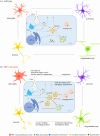Endo-lysosomal dysfunction and neuronal-glial crosstalk in Niemann-Pick type C disease
- PMID: 38368932
- PMCID: PMC10874755
- DOI: 10.1098/rstb.2022.0388
Endo-lysosomal dysfunction and neuronal-glial crosstalk in Niemann-Pick type C disease
Abstract
Niemann-Pick type C (NPC) disease is a rare progressive lysosomal lipid storage disorder that manifests with a heterogeneous spectrum of clinical syndromes, including visceral, neurological and psychiatric symptoms. This monogenetic autosomal recessive disease is largely caused by mutations in the NPC1 gene, which controls intracellular lipid homeostasis. Vesicle-mediated endo-lysosomal lipid trafficking and non-vesicular lipid exchange via inter-organelle membrane contact sites are both regulated by the NPC1 protein. Loss of NPC1 function therefore triggers intracellular accumulation of diverse lipid species, including cholesterol, glycosphingolipids, sphingomyelin and sphingosine. The NPC1-mediated dysfunction of lipid transport has severe consequences for all brain cells, leading to neurodegeneration. Besides the cell-autonomous contribution of neuronal NPC1, aberrant NPC1 signalling in other brain cells is critical for the pathology. We discuss here the importance of endo-lysosomal dysfunction and a tight crosstalk between neurons, oligodendrocytes, astrocytes and microglia in NPC pathology. We strongly believe that a cell-specific rescue may not be sufficient to counteract the severity of the NPC pathology, but targeting common mechanisms, such as endo-lysosomal and lipid trafficking dysfunction, may ameliorate NPC pathology. This article is part of a discussion meeting issue 'Understanding the endo-lysosomal network in neurodegeneration'.
Keywords: NPC1; cholesterol; endo-lysosomal trafficking; glia; neurons.
Conflict of interest statement
We declare we have no competing interests.
Figures


References
Publication types
MeSH terms
Substances
LinkOut - more resources
Full Text Sources
Medical
